Tea in March
In the world of Chanoyu, March is a time when Sen no Rikyū, 千利休, Thousand ’s Rich-quit, is honored and memorialized.
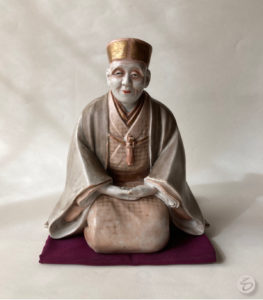
Rikyū was born in 1522 and died in 1591. His death, according to the old lunar calendar, was on the 28th day of the second month in 1591. That year had an added ‘leap’ second lunar first month to make adjustments for lunar events to more closely ally with the solar calendar. The actual date of his death was April 21.

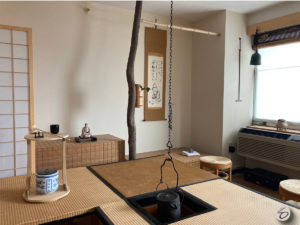

Kake-mono, 掛物, hang-thing, Rikyū no e, 利休の絵, Rikyū’s picture. With calligraphy from the left:
釈迦仏天下人
Sha-ka Butsu ten-ka-jin,
Explain-‘ka’ Buddha heaven-down-person
[Shaka or Sakya is Buddha’s family name].
仲尼仁天下人
Chū-ji Jin ten-ka-jin,
Relation-nun Benevolence heaven-down-person
[Chūji, in Chinese, Kongzi is Confucius’ family name].
唯比利休
tada-hi Ri-kyū
only-same Rikyū
the same is for
茶天下人
Tea ten-ka-jin
Tea heaven-down-person.
by Sen-gai Gi-bon, 仙厓義梵, Hermit-precipice Righteous-Sanskrit. [1750-1837].
L. 5.5 shaku kane-jaku. Print.

The ichi-jū-giri style of hanaire is one of the three hanaire that Rikyū made of three pieces of bamboo given to Toyo-tomi Hide-yoshi, 豊臣秀吉, Excellence-retainer Surpass-luck, in recompense for the three bales of rice Hideyoshi had given to the Hō-jō, 北条, North-branch, clan during a battle in O-da-wara, 小田原, Small-ricefield-plain. The intention was to have Hideyoshi make green bamboo knives, take-mitsu, 竹光, bamboo-light, to commit se-ppuku, 切腹, cut-belly. Instead, Rikyū made three hanaire out of the bamboo. The word take-mitsu, referring to the inference to bamboo knives, may be wordplay on take mitsu, 竹三, bamboo three, referring to the three pieces of bamboo. If this is true, it would mean that the three hanaire made by Rikyū were green bamboo, and green bamboo hanaire are associated with flowers offered in a cemetery.


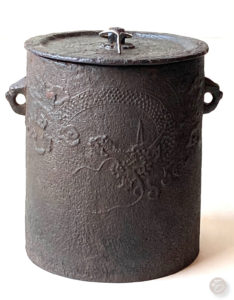
The dragon is emblematic of the emperor, and is a Buddhist symbol of enlightenment. The clouds represent the brain, and the dragon brings rain. The kan-tsuki, 鐶付, metal ring-attach, also represent dragon heads. H. 4.8 sun kujira-jaku, lid diam. 4 sun kujira-jaku: the relationship between the height of the vessel and the diameter of the lid has an 8 bu kujira-jaku difference. The number eight is emblematic of Infinity in Space.
There is a limit to the size of the kama to be hung over the ro, as the opening of the rodan is one shaku kane-jaku. A hanging kama is naturally going to swing, and a kama with a large diameter would swing and damage the walls of the rodan. In general, the kantsuki of a kama are set rather high on the sides and even the shoulder of a kama, rather than further down the sides. The large kan may aid in orientation.
Bon-shō, 梵鐘, Brahma-bell, Buddhist temple bell. A kama could be regarded as a manifestation of the hō-ju, 宝珠, treasure-jewel. The hōju is a symbol of combined water and fire, undifferentiated In and Yō.
Ancient Chinese temple bells were adopted by Japan to be used to announce the time and to summon people. The supporting lug, called ryū-zu, 龍頭, dragon-head, are most often composed of two dragons. The pair may be depicted facing each other often with a wish-granting jewel in both their mouths, or facing away from each other. A kama used in Chanoyu frequently has kan-tsuki, 鐶付, metal ring-attach, lugs that are in the form of dragon heads. Metal rings are slipped into the dragon mouths.
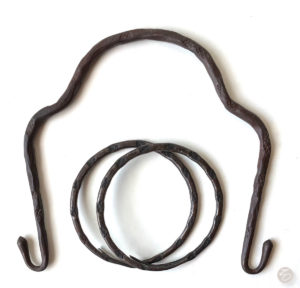
The diameter of the kan is equal to the interior rim of the lid of the kama. If the large kan were to be straightened flat, the length of the metal rod would be 9 sun kujira-jaku. The length of standard kan when straightened, are the same as the length of a pair of metal ‘Rikyū’ hi-bashi, 火箸, fire-rods, used with the fu-ro, 風炉, wind-hearth. There are other designs of the tsuru and the kan. Rings that are permanently held in the kantsuki of a furo are placed upright when there is a fire in the furo.
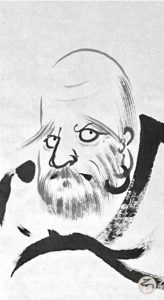
The pair of metal rings may have a connection with Daruma, who is depicted wearing large hoop earrings. They would be made of gold. In ancient times, some gold was kept on one’s person to pay for some unexpected expense. The Buddha is depicted with long pendant earlobes with holes in them indicating that once they were weighted down with very heavy gold earrings. Gautama, the young Buddha, was a wealthy prince who renounced his riches.
In Chinese Medicine gold has been used to treat skin conditions (skin ulcers, smallpox sores, mercury removal), diseases such as measles, detoxicate the body, relieve mental disorder, stop coughing, cure typhoid fever, as well as prescribing animal and plant-based medicines that likely contained gold in trace amounts.
The kan fit into the kantsuki of the kama, and in terms of Japanese design, the kantsuki are also identified as mimi, 耳, ears. The kan in the kantsuki could be called mimi-kazari, 耳飾, ear-ornament. It is thought that images of Daruma wearing earrings was before his enlightenment, and images of him without earrings is after his awakening. Just as the Buddha gave up his earthly wealth and removed his priceless gold earrings.
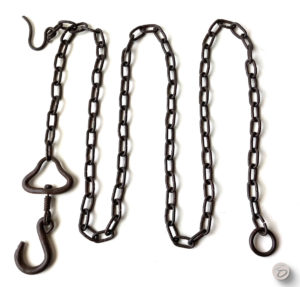
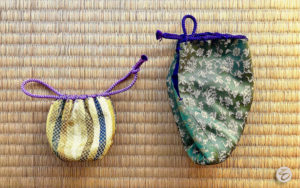
There are several other utensils in Chanoyu that have features somewhat similar to the chain. The cord of the shifuku for a cha-ire, 茶入, tea-receptacle, and a cha-wan, 茶碗, tea-bowl, when untied, have a loop, receptive, In, 陰, at one end, and a straight piece, uchi-dome, 打止, hit-stop, penetrative, penetrative, Yō, 陽, at the other. The take jizai, bamboo hanger, has a loop of hemp cord at the top of the bamboo, and a wooden hook at the bottom. They are not exactly mimicking the chain features, but have similar functions.

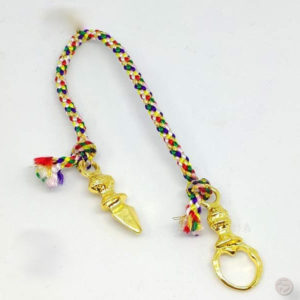
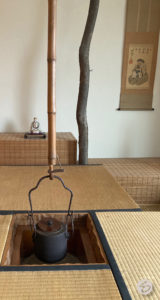
Small Tearoom setting.
Toko-bashira, 床柱, floor-post, katsura, 桂, katsura, Cercidiphyllum japonicum, also called cinnamon bark tree.
The tokobashira in a small Tearoom often has the bark left intact on the post.
Figure of Sen no Rikyū, porcelain with color glazes. Unmarked, possibly Ku-tani yaki, 九谷焼, Nine-valley fired.
Ito-maki gama, 糸巻釜, thread-wrap kettle, tetsu, 鉄, iron, with Kara-kane futa, 唐銅蓋, Tang-copper lid.
Take-zao, 竹竿, bamboo-pole, called a take-ji-zai, 竹自在, bamboo self-exist.
The bamboo pole hanger for a kettle in the Tearoom was a favorite of Rikyū. The bamboo pole is appropriate for a small Tearoom which is in harmony with its humbleness. Most cha-gama, 茶釜, tea-kettle, are made of iron, and some have a dark, rusty, textured patination, which would be in contrast with a lid that has smooth surface. This contrast creates an esthetic that is called wabi, 侘, timeworn. Wabi does not mean uncleanness. If a utensil can be cleared of soil or dust, it should be cleaned. There is an expression in Chanoyu regarding the beauty of the humble which is called ki-rei wabi, 奇麗事, strange-beauty timeworn. The word kirei most often means pretty, lovely, and, especially,clean.
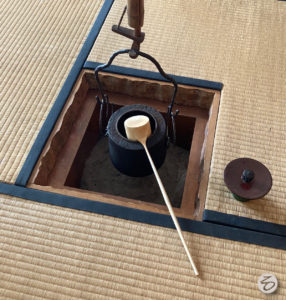
The height of the kama relative to the robuchi is the thickness of a finger between the hi-shaku, 柄杓, handle-ladle, where it crosses the tatami heri, 縁, binding. Although the size of the kama may vary, the place where the bottom of the kama joins the top, called the ha-ochi, 羽落, wing-drop, should align just a little above the top of the ro-dan, 炉壇, hearth-foundation. The haochi is a remnant where a hane, 羽, wing, flange around the kama was located, but through time may have rusted away. This aspect of the absence of the hane has been intentionally copied to suggest a feeling of wabi, 侘, timeworn.

Take-ji-zai, 竹自在, bamboo self-exist, go-ma dake, 胡麻竹, foreign-hemp [sesame] bamboo: length of bamboo pole is 5 shaku kane-jaku.
Like the chain, the jizai has a loop, In, at the top, and a hook, Yō, at the bottom. And both, for convenience and necessity, have independent adjustment devices.
The term sesame bamboo refers to the naturally occurring tiny, black specks on the skin of the bamboo, which are likened to kuro-go-ma, 黒胡麻, black foreign-hemp, sesame seeds.
The pole is oriented so that the root end of the bamboo is at the bottom of the pole, as though it were growing out of the water in the kama.

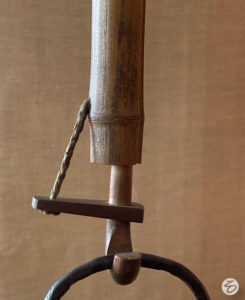
Both of the cords are made of braided asa, 麻, hemp. Hemp fibers, bast, can have a natural length of up to fifteen feet long.
The pictured take jizai is modeled on Rikyū’s ‘nana fushi’ take jizai, 七節, seven nodes. The seven nodes create six sealed chambers, and it is possible that the six chambers may be identified with, in Japanese, roku-kan, 六間, six-chambers.
The height of the ceiling of Rikyū’s yojōhan chashitsu is 5.9 sun kane-jaku. The height of the ceiling in a large or eight-mat room is much higher than the yojōhan, so that the chain is much longer than the bamboo hanger.
Sen no Rikyū had a bamboo walking stick called a ro-ji zue, 露地杖, dew-ground staff. It was made of bamboo that had nana–fushi, 七節, seven-nodes. The seven nodes are rings, and may be identified with shichi-rin, 七輪, seven-rings, also shichi-rin, 七厘, seven-(round)coins, which refers to a portable earthen charcoal brazier (for cooking). The name comes from the meager amount of money it cost for charcoal to cook with, or seven rin, meaning round coins. In Shin-gon, 真言, True-word, Buddhism, there is a reference to shichi-rin, read shichi-ri ke-kkai, 七里結界, seven-leagues tie-which, refers to the seven boundaries to keep demons from interfering with training, and to keep trainees from intermingling. The Kanji for the lengths of ri, 里, and rin, 厘, are that one ri equals nearly thirteen thousand rin.
The six rings may relate to the roku-kan, 六鐶, six-metal rings, of the shaku-jō, 錫杖, tin-staff, a ring for each of the Six Realms of Jizō, which is called the Roku-dō, 六道, Six-ways, from hell to heaven. The bamboo pole hangs between the extremes of the hell-like fire of the sunken hearth to the ceiling which is named ‘heaven-well.’
The Roku-dō, 六道, Six-ways, from hell to heaven:
Ten-jō, 天上, Heaven-up.
A-shu-ra-dō, 阿修羅道, Praise-discipline-spread-way: life as a demigod.
Nin-gen-dō, 人間道, Person-interval-way: life as a human.
Chiku-shō-dō, 畜生道, Animal-life-way: life as a beast.
Ga-ki-dō, 餓鬼道, Hungry-demon-way: life in starvation in a Buddhist hell.
Ji-goku-dō, 地獄道, Earth-prison-way: hell.

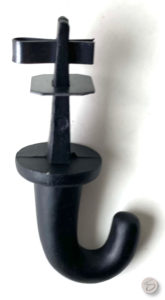
A kettle hanging from a chain or bamboo pole is hung from a hook in the ceiling that is named a hiru-kugi, 蛭釘, leech-hook. This iron hook gets its name from its shape that resembles a leech. The form of the hook is J-shaped, is round in section, and has a rounded tip, with a matte black finish. A ceiling is called a ten-jō, 天井, heaven-well.
In Japanese mythology, there is a renowned leech in heaven. It, or rather, he, is the son of I-za-na-mi, 伊邪那美, and I-za-na-gi, 伊邪那岐, the primal couple. Even until the age of three, he could not stand, and was called hiru-ko, 蛭子, leech-child. He was put into a camphor wood boat, and set adrift on the river of heaven. In time, he becomes known as the god, Ebisu, 夷, Barbarian, and is the god of fishermen. The word tsuri, 釣, means to fish, and with a metal hook. Izanagi and Izanami created the Japanese islands when Izanagi stirred around the primal sea with a long spear, nagi-nata, 薙刀, mow-sword, polearm with curved single-ed blade. The weapon was called the Ame-no-nu-hoko, 天沼矛, Heaven-‘s-lake-halberd.
Ebisu is often paired with Dai-koku, 大黒, Great-black, who is the god of rice. The form of the sukigi gama is roughly modelled on a rice cooker, meshi-gama, 飯釜, rice-kettle.
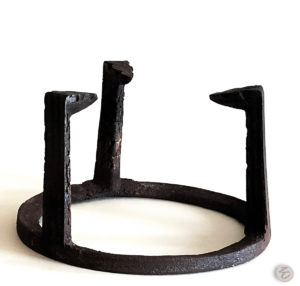
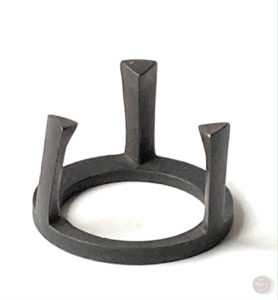
When using the hanging kettle or the kettle resting on wooden planks, the gotoku is not used. In such a circumstance, Rikyū would prefer to use a gotoku futaoki, which means that there is some special significance in the gotoku.
A gotoku has been a standard utensil used in daily life to support a vessel over a fire. For some purposes the ring is upright and the tsume, 爪, talons, are down in a bed of ash. The gotoku that would be used in the furo has one-third of the ring absent to allow for a round tile to be in the same location. When the gotoku is in the furo or the ro, the ring is hidden in the ash bed, so that only the three talons are visible. Because the word tsume, talon is used, it could mean that the talons can be identified with an animal that has three talons. Hawks and eagles have four talons on each foot. Some dragons have three talons, and as there are dragons depicted on the kantsuki, perhaps the animal is a dragon. Asian dragons have five, four, or three talons on each of their four legs. Dragons are always in pursuit of the hōju, the wish-granting jewel of immortality. The kama may represent the hōju, that is touching the talons, but not in the dragon’s clutch. They are still in pursuit.
The most formal presentation of Tea using the furo that has a gotoku, the ash bed has small, damp ash spoonful laid on the entire surface, and this treatment is called uroko-bai, 鱗灰, scale-ash. The word uroko refers to fish scales, and dragons have scales that are likened to the scales of the koi fish. The ash bed in the ro is covered with a layer of shimeshi-bai, 湿灰, damp-ash. The ash beds of the furo and the ro being damp, implies that the ash bed is symbolic of water. Protection from fire? The sea? Dragons bring rain.
A dragon with five talons was reserved only for the emperor of China. A dragon with four talons is identified with the aristocracy and Korea. A dragon with three talons is identified with lesser beings and Japan. Such classification is centered in China.
Dragon talon can be written, 龍爪, and read ryū–sō, and the word ryū-so, can be written, 琉装 gem-attire, that refers to traditional Okinawan clothing, and Okinawa, part of the Ryūkyū islands, which is identified with dragons with four talons.
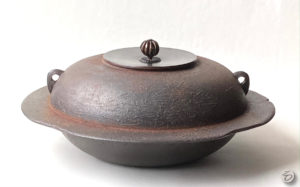
In the month of April, Urasenke uses a suki-gi–gama, 透木釜, thin-wood kettle, which has a wide flange around the middle that rests on small planks of wood set on the shoulder of the ro-dan, 炉壇, hearth-foundation. Many reasons can be imagined why Urasenke uses the hanging kettle in March, and the flanged kettle in April. This can be deemed futile, because Omote-sen-ke, 表千家, Front-thousand-family, exchanges them: using the flanged kettle in March and the hanging kettle in April. Rikyū said that one can make fine Tea with only one kettle. Perhaps that is why, Urasenke uses the hanging kettle in March, while Omotesenke, the next-door neighbors use the flanged kettle. Then they switch kama, metaphorically.
In Chanoyu, tea was made using the furo, and the furo was kiri-awase, 切合, cut-join, or kiri-kake, 切掛け, cut-hang. This type of furo has the kama sitting directly on the collar of the furo, so that a gotoku was unnecessary. It was the creation of the ro, that a gotoku was needed, just as it was common practice to use a gotoku in the standard i-ro-ri, 囲炉裏, enclose-hearth-inner, that was and is in many traditional homes. The ro, 炉, of Chanoyu is an adaptation of the irori.
It is said that Mura-ta Shu-kō, 村田珠光, Village-ricefield Jewel-bright, was the first to cut a ro in the floor of a Tearoom. The ro was perfected by Take-no Jō-ō, 武野紹鴎, War-field Help-gull, and Sen no Rikyū.
It was common practice to use gotoku in the irori with the ring upright and the legs in the ash. It was Rikyū who turned the gotoku over, so that the three legs were upright and the ring in the ash. Not having the gotoku in the ro in the third and fourth month, and using the gotoku futaoki, we are remembering Rikyū when handling and turning it over.
Events in March and April that are relative to Rikyū including the most important is his suicide in the third month. As Rikyū was a Buddhist, the birth of the Buddha must have been of exceeding importance, and the Buddha was born in the fourth month.
Rikyū poem on the futaoki. A key word is ashi, 足, which means foot, leg, paw, arm, etc.
Futaoki ni mitsu ashi araba hitotsu ashi mae ni tsukau to kokoro-eteoke.
蓋置に三つ足あらば一つ足 まへに使ふと心得ておけ。
Lid place in three feet if has one foot forward in use and mind-acquire [know].
The gotoku was one of seven objects Rikyū chose to use as a futa-oki. In one of his Hundred Poems on Chanoyu, he directs that a futaoki that has three feet, one of the feet is the shōmen. Of the seven ‘futaoki’ those with three feet are the gotoku, mitsu-nin-gyō, 三人形, three-person-type, and the mitsu-ba, 三つ葉, three-leaves, sazae, 栄螺, turbot shell. With the three dolls, the one with a tied belt is the constant shōmen. The spiral shell has rudimentary ‘feet’, and the shōmen changes when inverted. The shōmen of the gotoku changes: when it is displayed as a ‘gotoku’, the ring is down and two feet are forward – shōmen, but when it is used as a futaoki, the ring is up and one foot is forward – shōmen. A gotoku futaoki is made of metal or ceramic, and there are sets made of the seven ‘futaoki.’ Ideally, one would collect individual objects, rather than acquiring a set, although they are useful when teaching and learning.
When handling the gotoku futaoki, and turning it over, the ring is turned away from the guest, toward the near wall. It is a Japanese tradition that the bottom of an object should not be seen by a guest. By turning the ring of the gotoku futaoki away from the guest indicates that the ring is the bottom of the gotoku.
Parts of the gotoku: wa, 輪, ring, ashi, 足, foot, tsume, 爪, talon, claw. The tsume is made in several shapes, including sasa-tsume, 笹爪, bamboo leaf-talon.
Tsuri-gama and Sukigi-gama.
The ro, 炉, hearth, that is used in the months of March and April does not utilize a go–toku, 五徳, five-virtues, to support the kama, 釜, kettle. In March, Urasenke hangs the kettle, tsuri–gama, 釣釜, suspend-kettle; which may be hung from a metal chain, kusari, 鎖, or a bamboo pole, take ji-zai, 竹自在. In April, the kama with a wide flange is rested on a pair of small blocks of wood, suki-gi, 透木, open-wood, placed on the ro-dan, 炉壇, hearth-foundation: suki-gi–gama, 透木釜, open-wood-kettle.
Perhaps there is some particular reason for this custom in how the two kama are used. After years of research, there seemed to be no obvious reason associated with the particular months. Neighbor family Omotesenke used the same style kama placement, but reversed, tsuri-gama in April and sukigi-gama in March. Perhaps there is another reason.
The basic directions are guarded by eight Buddhist deities, which are different from the above eight groups of deities. North – Sen-jū-kan-non, 千手観音, Thousand-hand See-sound; North-east – Ko-kū-zō, 虚空蔵, Empty-void-treasure; East – Mon-ju, 文殊, Literary-particularly; South-east – Fu-gen, 普賢, Universal-wisdom; South – Sei-shi, 勢至, Strength-attain. These five deities are Bodhisattvas, Bo-satsu, 菩薩, Sacred tree-buddha, transitional to become Buddhas. The other deities are located variously; South-west – Dai-nichi Nyo-rai, 大日如来, Great-sun Like-become; West – Fudō Myō-ō, 不動明王, Un-move Bright-king; Northwest – A-mi-da Nyo-rai, 阿弥陀如来, Praise-increase-steep Like-come.
These eight deities are also identified with twelve animals of the Asian zodiac, jū-ni-shi, 十二支, ten-two-branch, as well as the twelve months. For the present study, the subject is limited to Fugen who is the guardian of the Southeast and the zodiac signs of Tatsu-Mi, 辰巳, Dragon-Snake. The word tatsumi is also written 巽, which is also read son, and means both southeast as well as obedient and modest.
Could the different ways that the kama is held over the ro have something to do with Fugen, dragons and snakes, or even directions? Perhaps the attributes of Fugen could provide some connections. Fugen is often depicted riding on a great white elephant, which is an animal greatly revered in India. Why not a dragon as does Kannon who rides a dragon? Or a snake? The deity Ben-ten, 弁天, Distinguish-heaven, is associated with a snake, and in my study, Benten plays no prominent role in the geomancy related to Chanoyu. Benten is a deity associated with ponds in gardens, and is often enshrined on islands in a garden.
Fugen is depicted sitting on a lotus pod surrounded by petals, which is a familiar device for most Buddhist deities. Fugen holds various objects. One in particular is a go-ko-sho, 五鈷杵, five-cobalt-pestle, which is based on the vajra, a metal implement that usually has talons at both ends. The gokosho is held by innumerable Buddhist deities, and it is the prime emblem of Tai-shaku-ten, 帝釈天, Emperor-Buddha-heaven, king of the gods, and his lightning bolt.
Of these eight Buddhist deities associated with the directions, those that hold a gokosho are limited to the Bosatsu, as Dainichi and Amida rarely hold any implement. Those Bosatsu that hold a gokosho are Senju Kannon and Fugen. It should be noted that Monju also carries a vajra, but it has three prongs, san-ko-sho, 三鈷杵, three-cobalt-pestle, and a bell on the other end of the vajra. Is it possible that Fugen’s double prong-ended gokosho represents two gotoku, one for the March tsuri-gama and the April sukigi-gama?
There is a possibility that this theory is wholly unfounded, as Monju’s three-prong and bell vajra, san-ko-rei, 三鈷杵, three-cobalt-bell, could represent the three-prong gotoku and the kama. However, the vajra and the bell are connected, whereas Fugen’s vajra approximates two gotoku.
The gokosho is composed of a shaft that is pointed at both ends, and each of the points is surrounded by four curved talons, thus creating five points. Some gokosho have all five points joined at the tips which is symbolic of peace, whereas with the points open, the object is regarded as a weapon. The three prongs of the tripod of the gotoku are called tsume, 爪, talon.
The gokosho / vajra represents the lightning bolt of Taishakuten. Chain lightning is a form of lightning that moves rapidly in a zigzag path with divided ends, or abruptly from cloud to cloud. The tsuri-gama may be hanging from a metal chain, kusari, 鎖, or a bamboo pole, take ji-zai, 竹自在. The word takejizai may evoke ta-ke-ji-zai-ten, 他化自在天, other-change-self-presence-heaven, which is the Buddhist heaven of controlling others’ emanations. Takejizaiten is a Buddhist concept that is an important part of the nature of existence, and is the sixth of the Roku-yoku-ten, 六欲天, Six-desire-heaven, Dai-ji-zai-ten, 大自在天, Great-other-change-self-presence-heaven, is a name of Shiva, who is one of the three great deities of the Hindu Trinity. These supreme deities are Brahma, the creator, Vishnu, the preserver, Shiva, the destroyer.
When the deities of the Trimurti are represented, the arrangement varies greatly. Often depictions show Vishnu with his serpent in the center, Brahma with four heads at Vishnu’s right side, and Shiva with his crescent moon at Vishnu’s left side. The key to recognizing them is to know their attributes.
Perhaps the association between the uses of the kama in third and fourth months have some connections with Buddhist observances. Because of the variances between the solar and lunar calendars, it is possible that one observance that could be associated with the third month / March is the Vernal Equinox, Shun-bun, 春分, spring-divide, called Hi-gan, 彼岸, Other-shore, which is an important Buddhist event equating it to entering the Pure Land paradise of Amida. An important Buddhist event in the fourth month is the birth of the Buddha, Kan-butsu-e, 灌仏会, Libate-Buddha-meeting.
For more information on Tea and Japanese culture in March, see also: Tea in March Part 2, Unryū Gama, Unryū Gama – A Petal Puzzle, Unryū Gama Picture Gallery, and Rikyū’s Take Jizai (video).

